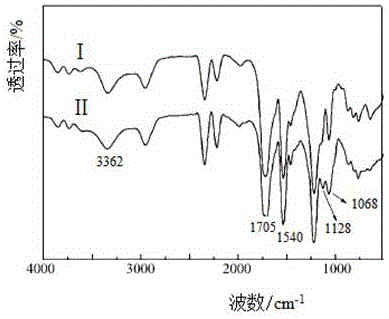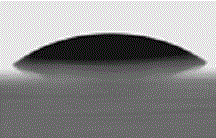Environmentally friendly hydrophobic polyurethane ink and preparation method thereof
A water-based polyurethane and hydrophobic technology, applied in the field of ink, can solve the problems of poor water resistance and mechanical properties, reduce the content of hydrophilic groups, and the performance of polyurethane is not obvious, so as to achieve low surface tension, improve mechanical properties, and expand applications range effect
- Summary
- Abstract
- Description
- Claims
- Application Information
AI Technical Summary
Problems solved by technology
Method used
Image
Examples
Example Embodiment
[0032] Example 1: Preparation of waterborne polyurethane
[0033] In a four-necked flask equipped with a stirrer, reflux condenser, and dropping funnel, 70.25g dehydrated polyester polyol and 29.75g isophorone diisocyanate, 4.00g dimethylolpropionic acid and 0.02g were added Dibutyltin dilaurate, heated to 80°C, react for 2 hours; then add 0.80g of 1,4-butanediol, continue the reaction for 1 hour, add 50.00g of acetone to control the viscosity of the reaction; cool the solution to 40 ℃, add 3.00g of triethylamine and 10.00g of acetone, neutralize for 10 minutes, add 0.75g of ethylenediamine, react for 20 minutes, under high-speed stirring, add 2.50g of sodium lauroyl glutamate emulsifier and 120.00g of deionized water; add 0.20g of NaHCO 3 Adjust the pH of the emulsion, add 0.20g of potassium persulfate and 10.00g of deionized water initiator solution, 10.00g of hexafluorobutyl methacrylate and 20.00g of 3-(methacryloyloxy)propane respectively. The fluorosilicon monomer mixture ...
Example Embodiment
[0038] Example 2: Preparation of water-based polyurethane
[0039] In a four-necked flask equipped with a stirrer, a reflux condenser and a dropping funnel, 45.00g dehydrated polyester polyol and 5.00g isophorone diisocyanate, 1.00g dimethylolpropionic acid and 0.01g were added Dibutyltin dilaurate, heated to 80°C and reacted for 2.5 hours; then 0.55g of 1,4-butanediol was added, and the reaction was continued for 1.5 hours, 150.00g of acetone was added to control the viscosity of the reaction; the solution was cooled to 40 ℃, add 2.00g of triethylamine and 8.00g of acetone, neutralize the reaction for 10 minutes, add 0.25g of ethylenediamine, react for 20 minutes, under high-speed stirring, add 1.50g of sodium lauroyl sarcosinate emulsifier and 50.00g deionized water; add 0.10g NaHCO 3 Adjust the pH value of the emulsion, and add dropwise an initiator solution of 0.10g of ammonium persulfate and 10.00g of deionized water, 5.00g of dodecafluoroheptyl methacrylate and 10.00g of vi...
Example Embodiment
[0040] Example 3: Preparation of waterborne polyurethane
[0041] In a four-necked flask equipped with a stirrer, reflux condenser and dropping funnel, 70.25g dehydrated polyester polyol and 29.75g isophorone diisocyanate, 4.00g dimethylolpropionic acid and 0.02g were added Dibutyltin dilaurate, heated to 80°C, react for 2 hours; then add 0.80g of 1,4-butanediol, continue the reaction for 1 hour, add 50.00g of acetone to control the viscosity of the reaction; cool the solution to 40 ℃, add 3.00g of triethylamine and 10.00g of acetone, neutralize and react for 10 minutes, add 0.75g of ethylenediamine, react for 20 minutes, under high-speed stirring, add 2.50g of myristoyl sarcosinate sodium emulsifier And 120.00g of deionized water; add 0.20g of NaHCO 3 Adjust the pH value of the emulsion, add 0.20g of potassium persulfate and 10.00g of deionized water initiator solution, 10.00g of tridecafluorooctyl methacrylate and 20.00g of tetravinyl-tetramethylcyclotetradecane, respectively. ...
PUM
| Property | Measurement | Unit |
|---|---|---|
| Fineness | aaaaa | aaaaa |
Abstract
Description
Claims
Application Information
 Login to view more
Login to view more - R&D Engineer
- R&D Manager
- IP Professional
- Industry Leading Data Capabilities
- Powerful AI technology
- Patent DNA Extraction
Browse by: Latest US Patents, China's latest patents, Technical Efficacy Thesaurus, Application Domain, Technology Topic.
© 2024 PatSnap. All rights reserved.Legal|Privacy policy|Modern Slavery Act Transparency Statement|Sitemap



